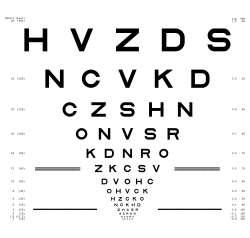When someone tells you they have 20/50 vision, it might sound confusing or even worrying. But what does that number actually mean? In simple terms, it describes how clearly you see compared to someone with normal vision. While 20/50 vision isn’t considered legally blind, it can still make daily tasks like reading, driving, or recognizing faces at a distance more difficult.
In this complete guide, you’ll learn what 20/50 vision really means, what causes it, how it affects daily life, and most importantly how you can improve it.
Understanding the Basics
The term 20/50 vision comes from the Snellen visual acuity test, which measures how clearly your eyes can distinguish details at a certain distance.
- The first number (20) represents the testing distance in feet 20 feet is the standard for eye exams.
- The second number (50) represents the distance at which a person with normal 20/20 vision can see the same object clearly.
So, if you have 20/50 vision, it means that what a person with normal eyesight can see clearly at 50 feet, you would need to stand only 20 feet away to see equally well.
Here’s how that compares to other common vision levels:
| Visual Acuity | Clarity Level | Typical Experience |
| 20/20 | Normal vision | Clear, sharp distance vision |
| 20/30 | Slightly below average | May squint to read small text |
| 20/40 | Mildly blurry | Some states require correction for driving |
| 20/50 | Moderate blur | Often requires glasses or contacts |
| 20/70 or worse | Poor vision | Needs medical or surgical correction |
Example: Imagine trying to read a road sign. A person with 20/20 vision can read it from 50 feet away. If you have 20/50 vision, you might not be able to read it until you’re just 20 feet from it.
Understanding Its Real World Impact
Having 20/50 vision doesn’t mean you’re blind, but it does mean your sight isn’t as sharp as it could be. Many people live with this level of vision, especially if it’s corrected with glasses or contact lenses.
Driving and Legal Standards
- In most U.S. states, an unrestricted driver’s license requires 20/40 vision or better in at least one eye.
- If you have 20/50 vision, you may still drive with corrective lenses.
- Always check your local DMV requirements, as they can vary.
Daily Challenges
People with 20/50 eyesight often experience:
- Trouble reading street or shop signs from a distance
- Eye strain when using screens for long periods
- Headaches from constant squinting or focusing
- Difficulty seeing clearly in low light conditions
Quote from an optometrist:
It isn’t dangerous, but it’s a sign your eyes are working harder than they should. Correcting it early can prevent strain and long-term discomfort.”
Common Causes of 20/50 Vision
Poor visual acuity can stem from several factors, from simple refractive errors to underlying eye diseases. Here are the main causes:
1. Refractive Errors
These are the most common and usually correctable with lenses:
- Myopia (nearsightedness): Distant objects appear blurry.
- Hyperopia (farsightedness): Close up tasks are difficult.
- Astigmatism: Vision is distorted due to an irregularly shaped cornea.
- Presbyopia: Age related difficulty focusing on near objects.
2. Eye Conditions
Sometimes, It is a symptom of something deeper:
- Cataracts clouding of the eye’s natural lens.
- Glaucoma damage to the optic nerve from pressure buildup.
- Macular degeneration affects central vision, common in older adults.
- Diabetic retinopathy caused by blood vessel damage in the retina.
3. Lifestyle and Environmental Factors
- Prolonged screen time and blue light exposure
- Poor lighting and ergonomics at work
- Skipping regular eye exams
- Nutritional deficiencies (especially Vitamin A and zinc)
Is Diagnosed
An eye exam is the only accurate way to determine whether you have 20/50 vision. Your optometrist will perform several tests to pinpoint the cause.
Standard Diagnostic Methods
- Visual Acuity Test: Uses a Snellen chart to measure your distance vision.
- Refraction Test: Determines if you need glasses or contact lenses.
- Slit Lamp Exam: Examines the cornea, iris, and lens for abnormalities.
- Retinal Exam: Checks the health of your optic nerve and retina.
Case Example:
A 35 year old office worker complains of blurred distance vision. Testing reveals 20/50 vision caused by mild myopia. After receiving prescription glasses, their visual acuity improves to 20/20 instantly demonstrating how quickly vision can be corrected with proper treatment.
How to Correct
The good news is that most cases of 20/50 eyesight are fully correctable. The treatment depends on the underlying cause.
1. Glasses or Contact Lenses
- Glasses are the simplest and safest solution.
- Contacts offer a wider field of view and are better for active lifestyles.
| Correction Method | Advantages | Disadvantages |
| Glasses | Easy to use, affordable | May fog or break |
| Contacts | Natural look, great for sports | Requires care and hygiene |
| LASIK | Permanent vision correction | Costly and requires healing time |
2. Laser Eye Surgery (LASIK or PRK)
Laser surgery reshapes the cornea to correct refractive errors. It’s quick (about 10 minutes per eye) and usually restores 20/20 vision.
Success rate: Over 90% of LASIK patients achieve 20/25 vision or better.
Recovery: Most people return to work within 1–2 days.
3. Orthokeratology (Ortho K)
These are special contact lenses worn overnight that temporarily reshape the cornea. Ideal for those who want clear daytime vision without surgery or glasses.
4. Natural Vision Care Tips
While you can’t “cure” 20/50 vision naturally, you can improve eye health with daily habits:
- Adhere to the 20-20-20 guideline: After every 20 minutes, gaze at an object located 20 feet away for a duration of 20 seconds.
- Eat foods rich in vitamin A, C, E, and omega 3 fatty acids.
- Avoid smoking and excessive alcohol.
- Get enough sleep to allow your eyes to recover.
Living Comfortably
Living with 20/50 eyesight doesn’t mean giving up your independence it just means adjusting a few habits.
- Upgrade lighting: Use bright, natural light to reduce strain.
- Increase contrast: Adjust your device settings for better readability.
- Schedule annual eye exams: Vision changes slowly, so early detection matters.
- Use accessibility tools: Magnifiers, large print screens, or high-contrast modes help in daily tasks.
Example: A teacher with 20/50 vision found that increasing text size on her computer and wearing blue-light glasses reduced her headaches dramatically within weeks.
Get Worse Over Time?
Yes, especially if caused by progressive myopia or age-related changes. However, consistent care can slow down deterioration.
Ways to prevent worsening:
- Wear prescribed corrective lenses regularly.
- Limit screen time or use anti glare filters.
- Protect your eyes from UV light with sunglasses.
- Maintain a nutrient rich diet for retinal health.
20/50 Vision vs. Legal Blindness
Many people confuse 20/50 eyesight with legal blindness, but they are very different.
| Condition | Visual Acuity | Status |
| 20/50 Vision | Moderate blur | Not legally blind |
| Legal Blindness | 20/200 or worse (with correction) | Qualifies under U.S. law |
Someone with 20/50 vision can usually correct it to 20/20 or near-normal levels using glasses or contacts, while legal blindness cannot always be improved even with corrective lenses.
When to See an Eye Doctor
You should schedule an eye exam if you:
- Struggle to see distant signs or faces
- Experience frequent headaches or eye strain
- Have sudden vision changes or blurry spots
- Notice glare or halos around lights
Tip: Adults should get their eyes checked every 1 2 years, or more often if they already wear corrective lenses.
Key Takeaways
- 20/50 vision means your sight is blurrier than normal but usually correctable.
- It’s commonly caused by refractive errors, not severe disease.
- Glasses, contacts, or LASIK can restore clear vision quickly.
- Regular eye exams are essential to prevent further decline.
- Healthy habits and proper lighting can make daily life much easier.
Frequently Asked Questions (FAQs)
Can you drive with 20/50 vision?
In most regions, you can drive if you wear corrective lenses that bring your vision to at least in one eye.
Is 20/50 vision bad enough for glasses?
Yes. Even moderate blur can strain your eyes and affect concentration, so glasses are often recommended.
Can 20/50 vision improve naturally?
Not significantly. While healthy habits help, optical correction or surgery is usually required for full clarity.
Is 20/50 vision considered poor eyesight?
It’s categorized as moderate visual impairment, but it’s far from blindness and often easily treatable.
Conclusion:
Having doesn’t mean your world must stay blurry. With the right correction, preventive care, and regular checkups, you can enjoy crystal-clear sight again. Remember your eyes are windows to your life’s experiences. Treat them with care, and they’ll serve you well for decades.



